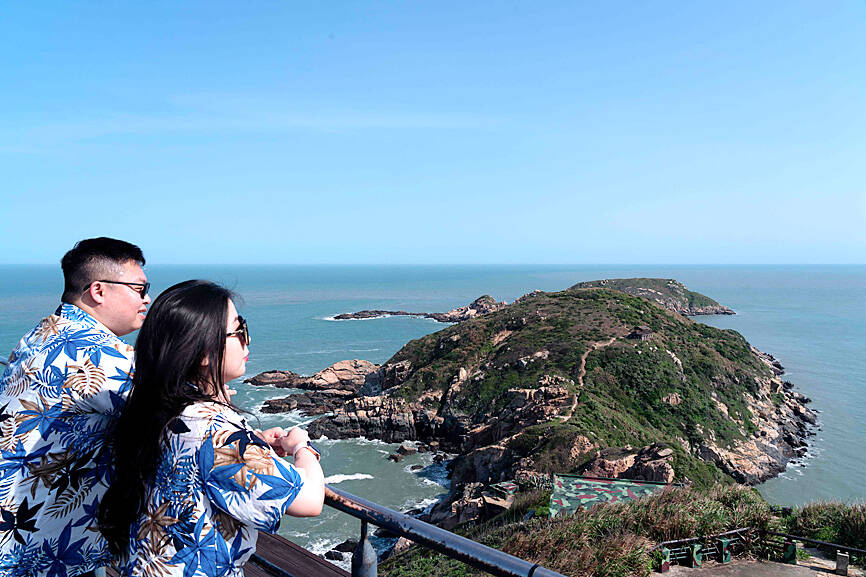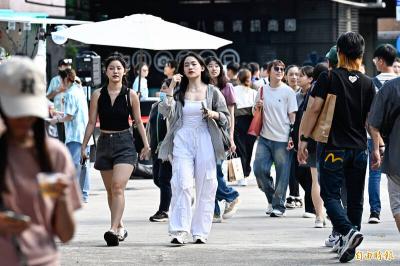Taiwanese hostel worker Wang Chuang-jen’s business took a hammering when undersea telecoms lines serving a Lienchiang County archipelago were cut in February.
“It was very inconvenient,” said the 35-year-old from Beigan (北竿), the county’s second-largest island, where customers struggled to book or pay online due to slow connectivity. “We all heavily depend on the Internet.”
The disconnection not only caused headaches for businesspeople such as Wang, it also highlighted Taiwan’s digital vulnerability at a time of heightened menace from China.

Photo: Jack Moore, AFP
The two cables were severed about 50km from the county within days of each other.
Locals, as well as the National Communications Commission, said Chinese fishing vessels or sand dredgers — which often drop anchor or scrape the seabed in Taiwanese waters — might have done the damage.
“I think China is aware of the situation,” Democratic Progressive Party Legislator Cheng Yun-peng (鄭運鵬) said. “It would have been easy to restrain such an act of sabotage, but it didn’t.”
There have been nearly a dozen such incidents since 2021, and Taiwanese authorities are seeking solutions.
While cables linking Lienchiang and Kinmen counties are shallow enough to be threatened by fishing vessels, experts have said that even the more deeply laid cables along the north, west and south of the counties’ main islands are susceptible to sabotage.
While its lines were cut, the Lienchiang archipelago — home to about 10,000 people and only a few kilometers from China — relied on a patchy mountain-based microwave backup system until repairs were made late last month.
Authorities are seeking a sturdier alternative on a nationwide scale.
The Ministry of Digital Affairs said it has a two-year, US$18 million plan to place satellite receivers in 700 places at home and abroad, to maintain government communications “during emergencies such as natural disasters or wars,” adding that it is “willing to cooperate with any qualified satellite service provider.”
Recent Chinese war games around Taiwan underlined the urgency.
The drills came after President Tsai Ing-wen (蔡英文) meeting with US House of Representatives Speaker Kevin McCarthy in California earlier this month.
During the visit, two US lawmakers reportedly talked with Tsai about Taiwan using Elon Musk’s Starlink satellite system, which has been deployed in Ukraine since its invasion by Russia.
Experts have said that the disruption in places such as Lienchiang has already furnished Beijing with invaluable intelligence.
“It definitely offers an opportunity for China to observe the digital resilience of the military and civilians in Matsu,” military expert Tzeng Yi-suo (曾怡碩) said in Taipei.
Fishers in Lienchiang, who rely on digital signals to take customers’ orders, described the frustrating disruption.
“The [Internet] speed was very, very slow, or the messages even couldn’t get through. When people called me, the line was cut before I could finish even one sentence,” fisher Wang Chia-Wen said.
Analysts said Taiwan’s undersea cables could be cut by uncrewed Chinese submarines, and their terrestrial terminals attacked with rockets or special forces.
“China’s invasion would try to pick off Taiwan’s communication settings,” said Richard Hu (胡瑞舟), a retired general and military expert at National Chengchi University. “The incidents this time have increased the doubt concerning Taiwan’s readiness level.”

Three Taiwanese airlines have prohibited passengers from packing Bluetooth earbuds and their charger cases in checked luggage. EVA Air and Uni Air said that Bluetooth earbuds and charger cases are categorized as portable electronic devices, which should be switched off if they are placed in checked luggage based on international aviation safety regulations. They must not be in standby or sleep mode. However, as charging would continue when earbuds are placed in the charger cases, which would contravene international aviation regulations, their cases must be carried as hand luggage, they said. Tigerair Taiwan said that earbud charger cases are equipped

Foreign travelers entering Taiwan on a short layover via Taiwan Taoyuan International Airport are receiving NT$600 gift vouchers from yesterday, the Tourism Administration said, adding that it hopes the incentive would boost tourism consumption at the airport. The program, which allows travelers holding non-Taiwan passports who enter the country during a layover of up to 24 hours to claim a voucher, aims to promote attractions at the airport, the agency said in a statement on Friday. To participate, travelers must sign up on the campaign Web site, the agency said. They can then present their passport and boarding pass for their connecting international

Temperatures in northern Taiwan are forecast to reach as high as 30°C today, as an ongoing northeasterly seasonal wind system weakens, the Central Weather Administration (CWA) said. CWA forecaster Tseng Chao-cheng (曾昭誠) said yesterday that with the seasonal wind system weakening, warmer easterly winds would boost the temperature today. Daytime temperatures in northern Taiwan and Yilan County are expected to range from 28°C to 30°C today, up about 3°C from yesterday, Tseng said. According to the CWA, temperature highs in central and southern Taiwan could stay stable. However, the weather is expected to turn cooler starting tonight as the northeasterly wind system strengthens again

Taiwan sweltered through its hottest October on record, the Central Weather Administration (CWA) said yesterday, the latest in a string of global temperature records. The main island endured its highest average temperature since 1950, CWA forecaster Liu Pei-teng said. Temperatures the world over have soared in recent years as human-induced climate change contributes to ever more erratic weather patterns. Taiwan’s average temperature was 27.381°C as of Thursday, Liu said. Liu said the average could slip 0.1°C by the end of yesterday, but it would still be higher than the previous record of 27.009°C in 2016. "The temperature only started lowering around Oct. 18 or 19